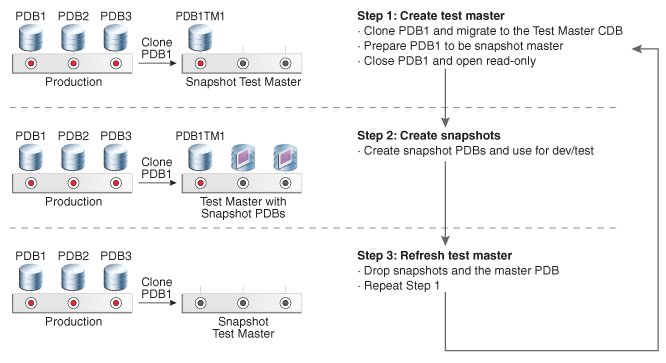9.7.4.1 Creating a Snapshot of a Pluggable Database
Creating an Exadata snapshot of a pluggable database (PDB) is the
simplest method for creating a snapshot because it requires no additional manual
steps. Two new clauses in the CREATE PLUGGABLE DATABASE statement
identify the PDB as an Exadata snapshot.
Creating individual Exadata snapshot PDBs is best used when creating snapshots for a smaller number of PDBs within a given CDB. The following figure shows a high-level example of a typical lifecycle for a PDB with two PDB snapshots.
Figure 9-12 Lifecycle of Exadata Snapshots Using PDBs

Description of "Figure 9-12 Lifecycle of Exadata Snapshots Using PDBs"
One of the benefits of Oracle Multitenant and PDBs is the ability to easily clone an existing PDB to create a test master and move it from one CDB to another. Oracle recommends that you clone your source PDB to create the test master and then migrate it to your test environment where you can perform any data scrubbing that may be needed. Once complete, the test master PDB can be used to create numerous Exadata snapshot PDBs.
An Exadata snapshot PDB is created as a PDB in the CDB. Like all other PDBs, an Exadata snapshot PDB is subject to the general limit for the maximum number of PDBs in a single CDB. For Oracle Database 12c release 1 (12.1), the limit is 252 PDBs in a single CDB. For Oracle Database 12c release 2 (12.2) and later, the limit is 4096 PDBs in a single CDB.
When creating an Exadata snapshot PDB, the command changes file
permissions on the test master PDB, marking the files as READONLY
in Oracle ASM. Consequently, if you want to delete the test master PDB, you must
first drop all the snapshot copies and change the test master PDB file permissions
back to READ WRITE.
Note:
If you drop the test master PDB before changing the file permissions to
READ WRITE, the command completes without error. However,
the underlying database files remain, and an entry is written to the database
alert log file. In this case, you must manually delete the files in Oracle ASM
to free up the space occupied by the files.
After creating the test master PDB, perform the following steps to create an Exadata snapshot PDB:
Parent topic: Creating Snapshots